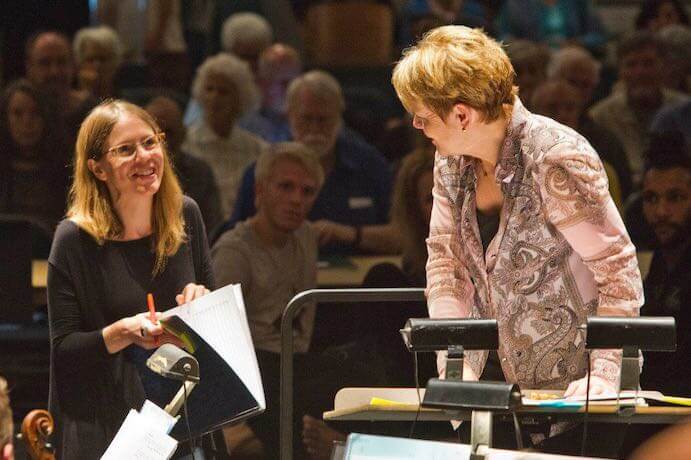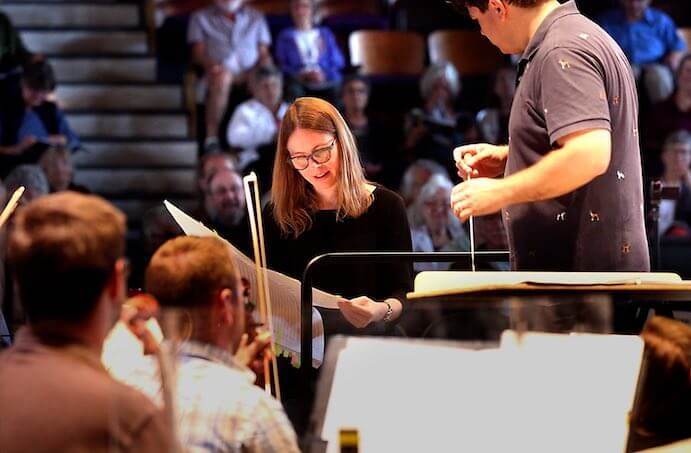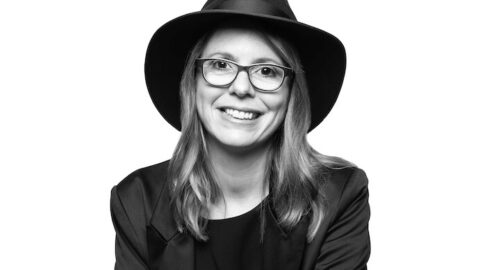London-born Anna Clyne is a GRAMMY-nominated composer of acoustic and electro-acoustic music. Since her stint as the Mead Composer-in-Residence for the Chicago Symphony Orchestra (2010–2015), Clyne has been one of the most acclaimed and in-demand composers of her generation, especially of orchestral works. On October 23-24, the Baltimore Symphony Orchestra, led by BSO Music Director Marin Alsop, will give the world premiere of Clyne’s Color Field (a BSO commission) on a program that also includes her 2018 work, Restless Oceans, which was composed for Alsop.
Marin Alsop has been a massive supporter of and collaborator with your music since Masquerade (2013). Given the importance of the composer-performer relationship, what has working with Alsop meant for your work, and how did this partnership start?
I first worked with Marin Alsop in the summer of 2010 at the Cabrillo Festival of Contemporary Music in Santa Cruz, California, where she programmed my first orchestral work, <<REWIND<<. Since this time, Marin has performed nearly all of my orchestral works, including my violin concerto, The Seamstress, and my cello concerto, DANCE, which she recorded with cellist Inbal Segev and the London Philharmonic, and was released on AVIE Records in 2020.
Writing a piece that I know Marin will premiere is a real inspiration for me – I love the way she moves and the way she connects with the musicians. Examples of these are Masquerade, which opened the last night of the Proms in 2013, a monumental event marking the first time in the Prom’s Last Night history that a woman took the podium. We released the recording of this thrilling performance as part of an album Mythologies – a collection of five orchestral works recorded live by the BBC Symphony Orchestra, also released on AVIE Records last year.
I feel a great sense of mutual trust with Marin. I know my music will be realized as I imagined it in her hands. Her support of my music has been a great honor and has certainly brought more exposure to my music both within the U.S. and abroad. It is unusual for a conductor to commit to a composer beyond one piece, or one performance of a piece. This is something that Marin has also done with other composers, and this is a great gift.

Both of your commissions for the Baltimore Symphony Orchestra (Abstractions and Color Field) take their inspirations from semi-abstract or non-objective art. With regard to Abstraction, you responded to works all made in your lifetime by mostly living artists. What drew you to these particular pieces, and have you had the opportunity to meet and discuss your musical response with any of them?
Abstractions is a suite of five movements inspired by five contrasting contemporary artworks from the Baltimore Museum of Art and from the private collection of Rheda Becker and Robert Meyerhoff, for whom this music honors. I did not have an opportunity to meet with the four living artists (all but Ellsworth Kelly), though I would be very curious to hear their reactions.
In drawing inspiration from these artworks, I tried to capture the feelings or imagery that they evoke, the concept of the work, or the process adopted by the artists. Such examples are the filtered blues and the contrast between light falling on the earthy stone and the mysterious moon that characterize VanDerBeek‘s Marble Moon; the long arching lines, compact energetic marks, and dense shifting forms of a system on the verge of collapse in Mehretu’s Auguries; the serene horizon with rippled water in Sugimoto’s Seascape; the stark juxtaposition of the energetic black and white lines that enlarge Kelly’s brushstrokes in RiverII; and the lines, which, inspired by Asian calligraphy and the structure of seashells, appear to dance in Marden’s 3.
The title of your other BSO commission, Color Field, refers to a movement of mid-20th century abstract painting, but it’s a much more complex and personal point of departure. You describe the piece as being commissioned by Bonnie McElveen-Hunter in honor of Melanie Sabelhaus, whose favorite color, “Hermès Orange,” led you to the work of the painter Mark Rothko, which led back to Sabelhaus. It’s a beautiful narrative, but I’m curious how this detail about her became so central to your process?
The central inspiration for Color Field is indeed a person: Melanie Sabelhaus, the honoree of this work. I began the creative process upon first meeting Sabelhaus in New York City, when I learned about her family, her Serbian roots, her work, and the music she loves. She is bold, audacious, generous, and a pioneer for women in business and philanthropic work.
She also loves the color orange – in particular Hermès Orange – and thus began my exploration of color. This led me to Mark Rothko’s Orange, Red, Yellow (1961) – a powerful example of the artist’s Color Field paintings, featuring red and yellow framing a massive swash of vibrant orange that seems to vibrate off the canvas.
While I explored creating music that evokes colors, I thought about synesthesia, a perceptual phenomenon in which a person hears sound, pitch, and tonal centers and then sees specific colors, and vice versa. Each movement of Color Field weaves in elements of the life of Melanie Sabelhaus. “Yellow” evokes a hazy warmth and incorporates a traditional Serbian melody, first heard as a very slow bass line, and then revealed in the middle of the movement in the strings and winds. In “Red,” the fires blaze with bold percussive patterns and lilting lines. In “Orange,” the music becomes still and breathes, and then escalates once more, incorporating elements of “Yellow” and “Red” to create “Orange” – the signature color of Melanie Sabelhaus.

I’ve been using traditional phrases (response, inspiration, etc.) to describe your relationship with the visual arts, but I feel this does you a disservice. The visual arts regularly play a role in your compositions, but you’re not just responding to a set of images — you seem to collaborate with the artist by creating something new. How would you characterize this relationship?
I see the relationship between music and visual art to be very visceral and the nature of the collaboration can shift between pieces. In the case of Abstractions and Color Field, I responded to existing pieces of art. However, sometimes the process is inverted, as in The Violin – a suite of seven pieces for multi-tracked violins. My dear friend and wonderful artist Josh Dorman created seven stunning animations for each of these seven pieces – the art was created in response to the music. In other instances, the two elements are created in conjunction with each other, creating a very symbiotic relationship, as in a recent work, Pardes, that I created in collaboration with London-based artist Jyll Bradley and Scottish Ensemble violist, Jane Atkins.
This symbiotic relationship between art forms also extends to collaborations with artists from other art forms, such as with choreographers and filmmakers. In other cases, there is not a collaborator, in which instances, I sometimes turn to creating art myself to assist with the creative process, as in Night Ferry, an orchestral work also included on Mythologies.
The first idea for Night Ferry was in fact a visual image of a dark turbulent wave, so I tried a new process — simultaneously painting the music whilst writing it. On my wall, I taped seven large canvasses side-by-side horizontally, each divided into three sub-sections. This became my visual timeline for the duration of the music. In correlation to composing the music, I painted from left to right, moving forward through time. I painted a section, then composed a section, and vice versa, intertwining the two in the creative process.
Pardes (2020) from Jyll Bradley on Vimeo.
Building on that, the video artists and dancers you employ in some of your chamber music works feel like you’re adding another layer to your music-making and the concert experience as a whole. How would you describe the theatrical and ambient elements of your orchestral works?
This Midnight Hour, an orchestral tone-poem of sorts, is a good example of a theatrical work of mine, a recording of which is also included in Mythologies. This draws inspiration from two poems. Whilst it is not intended to depict a specific narrative, my intention is that it will evoke a visual journey for the listener. The two poems are Harmonie du Soir by Charles Baudelaire, which has some wonderfully evocative imagery and musical references…
The season is at hand when swaying on its stem
Every flower exhales perfume like a censer;
Sounds and perfumes turn in the evening air;
Melancholy waltz and languid vertigo!
(Translated by William Aggeler)
…and a very short poem by Juan Ramón Jiménez:
Music –
a naked woman
running mad through the pure night!
(Translated by Robert Bly)
I often explore different approaches to orchestration to evoke more ambient elements – be they the orchestration of reverberation – for example, in my work Within Her Arms, a work for 15 individual strings. The music opens with a simple melody in the first violin, and other violins sustain the pitches of the melody to create the sonic illusion of ambient reverb. I also explore other electronic processes in my orchestration, such as delay, reversing sounds, time expansion, compression, and of course, processes that directly translate to orchestration, such as pitch shifting and octave transpositions, and combining colors of different instruments in unisons.
I CARE IF YOU LISTEN is an editorially-independent program of the American Composers Forum, funded with generous donor and institutional support. Opinions expressed are solely those of the author and may not represent the views of ICIYL or ACF.
A gift to ACF helps support the work of ICIYL. For more on ACF, visit the “At ACF” section or composersforum.org.
























